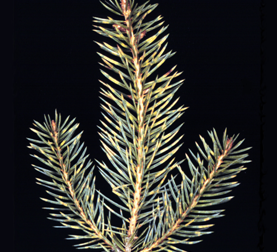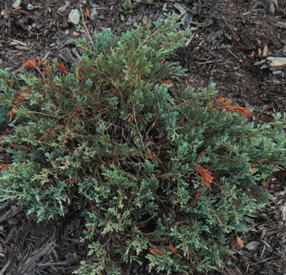
What is Weir’s cushion rust?
Weir’s cushion rust is a needle disease that disfigures and reduces growth of spruce trees (Picea spp.) of all ages. This disease has been known in both eastern and western regions of the United States, but was recognized in Wisconsin for the first time in 2002.
What does Weir’s cushion rust look like?
Needles on current year’s shoots affected by Weir’s cushion rust may develop yellow spots or bands in the summer and fall. These spots and bands may intensify to give needles a bright “green and gold” appearance the following spring, when tiny blister-like pustules (a type of fungal reproductive structure) develop in the yellow areas. Microscopic examination of these pustules is required for diagnosis of the disease. Affected one-year-old needles continue to yellow, turn brown, and fall off as the spring and summer progress. Trees badly damaged by Weir’s cushion rust will have thin crowns due to repeated loss of the previous year’s needles.
Where does Weir’s cushion rust come from?
Weir’s cushion rust results from colonization of spruce needles by the fungus Ceropsora weirii (formerly Chrysomyxa weirii). This fungus overwinters in needles infected during the previous growing season. In late summer, or more typically the following spring, C. weirii produces spores in the pustules that develop on the needles. These spores can be blown by wind or splashed by rain to newly emerging needles on the same tree or other trees. Spore germination is followed by infection of young needles.
Can I save a tree affected by Weir’s cushion rust?
Apply fungicides containing chlorothalonil to trees affected by Weir’s cushion rust to prevent new needle infections. Make the first application when 10% of the buds have broken and two additional applications at seven to 10 day intervals thereafter. Fungicide applications do not kill the fungus in needles that are already infected, so be sure to begin applications promptly and complete the spray program, to ensure thorough coverage and protection of new foliage. Please be sure to read and follow all fungicide label instructions to ensure that you use the product in the safest and most effective manner possible. Needles infected by C. weirii eventually die. The fungus does not continue to live or produce spores on these dead needles. Therefore, destruction of dead needles is not necessary.
How do I avoid Weir’s cushion rust in the future?
Do not accept and plant landscape or nursery stock affected by Weir’s cushion rust. Inspect established spruce trees (in both landscape and nursery settings) in late summer and fall for evidence of Weir’s cushion rust (e.g., yellow spots and bands on the current year’s needles). Inspect suspect trees again in spring for these symptoms, as well as pustules of C. weirii on the previous year’s needles. In nurseries, move affected trees to areas where the disease is not already present. Use fungicide applications to prevent establishment of the fungus on new trees or in previously unaffected nurseries and landscapes.
For more information on Weir’s cushion rust:
Contact the University of Wisconsin Plant Disease Diagnostics Clinic (PDDC) at (608) 262-2863 or pddc@wisc.edu.
Authors: Glen R. Stanosz, UW Madison Plant Pathology, and Forest Ecology and Management
Last Revised: 03/02/2024
D-number: D0124
References to pesticide products in this publication are for your convenience and are not an endorsement or criticism of one product over similar products. You are responsible for using pesticides according to the manufacturer’s current label directions. Follow directions exactly to protect the environment and people from pesticide exposure. Failure to do so violates the law.
Thanks to Brian Hudelson for reviewing this document.
A complete inventory of UW Plant Disease Facts is available at the University of Wisconsin-Madison Plant Disease Diagnostics Clinic website: https://pddc.wisc.edu.
Send a Plant Sample for Analysis
Be cautious when self-diagnosing plant health issues. Very few diseases can accurately be diagnosed by eye.
Contact the UW Plant Disease Diagnostics Clinic (PDDC), and for a small fee, clinic staff can examine a plant, determine the cause of the disease/disorder, and provide advice on how to control or prevent the issue.
Download Article





 Swiss Needle Cast
Swiss Needle Cast Conifer Disease Quick Reference
Conifer Disease Quick Reference Phomopsis Tip Blight
Phomopsis Tip Blight Dothistroma Needle Blight
Dothistroma Needle Blight


